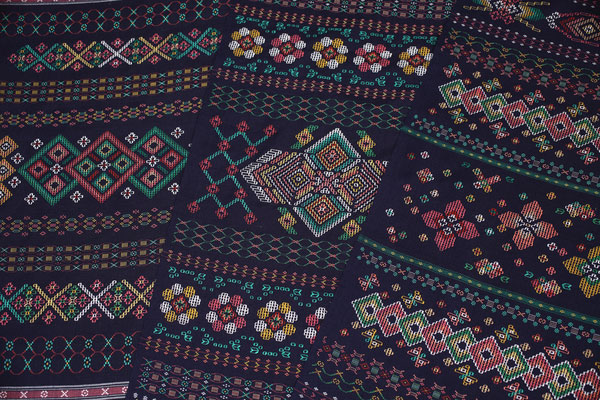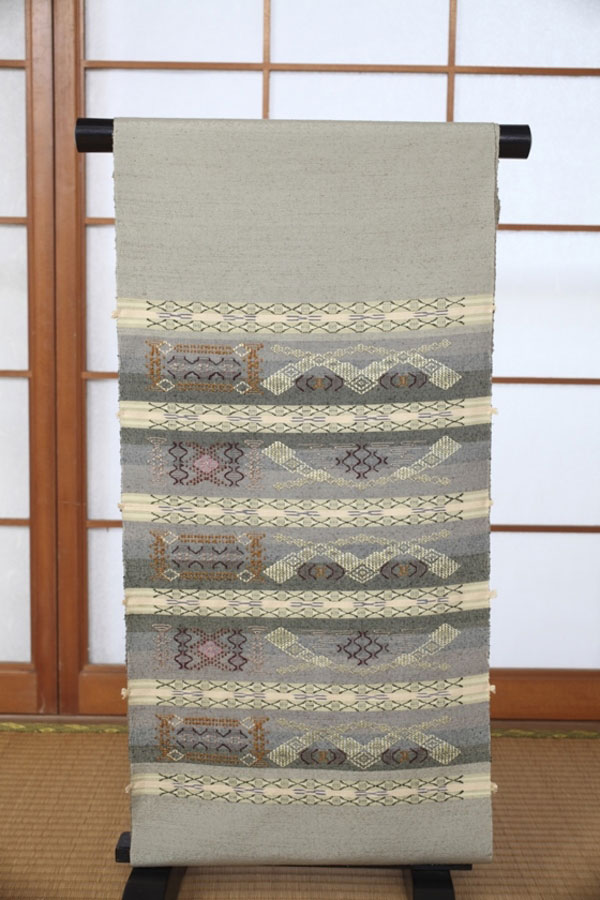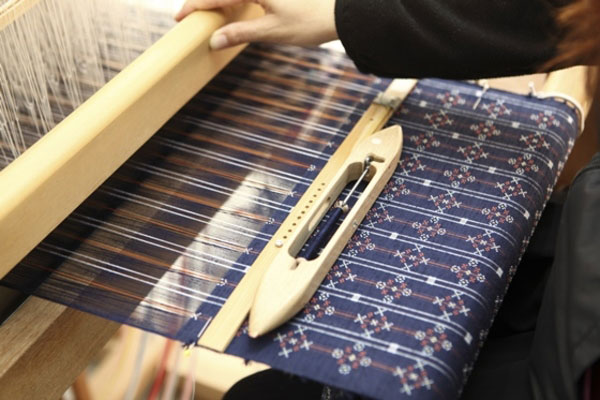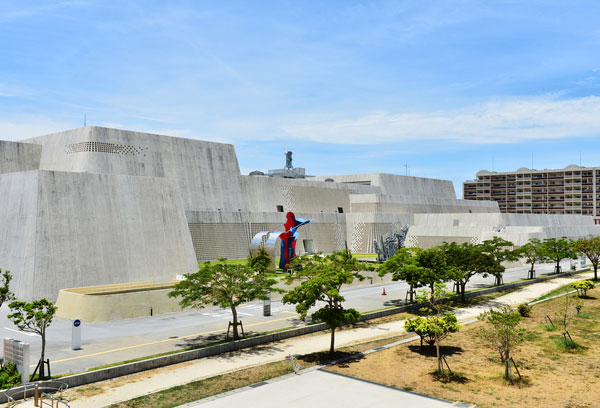 Photo:Okinawa Convention&Visitors Bureau
Photo:Okinawa Convention&Visitors Bureau
- Woven textiles
- Okinawa
Yomitanzan-hanaori textiles Yomitanzan hanaori
Top-level techniques and charming flower patterns
Exquisite textile made for the Ryukyu royal family
Description
What is Yomitanzan-hanaori textiles ?
Yomitanzan hanaori is a textile produced in the village of Yomitan, Okinawa. The threads of this craft are first dyed before being woven in a geometric, flowerlike design. This craft is woven with silk or cotton threads dyed with plant-based dyes like indigo, fukugi, and sappanwood. Traditionally, the base fabric of Yomitanzan hanaori is navy blue, dyed with Ryukyu indigo and decorated with red, yellow, or white flower patterns. The measurements and designs of each flower pattern are decided and have specific meanings. Jinbana or rhododendron resembles a coin and represents financial success, while ojibana is fan-shaped and means prosperity of descendents, and kajimayabana, a pinwheel-shaped design is based on an Okinawan custom that celebrates one's ninety-seventh birthday and wishes for a long lifespan. By combining these basic designs with stripes and checkered patterns, the designs can become even more complex and appear three-dimensional, giving the craft a gorgeous touch. As it takes much time and effort to make, it was a highly valued textile which people other than members of the royal family or residents of Yomitan were strictly banned from wearing during the Ryukyu dynasty era.
History
 Photo:Okinawa Convention&Visitors Bureau
Photo:Okinawa Convention&Visitors Bureau
It is not clear when the production of Yomitanzan hanaori initially began. However, it is widely believed that the production of the textile started sometime in the 15th century when the Ryukyu Kingdom (now Okinawa, 1429-1879) was active in trading with China and Southeast Asian countries. Due to this trade, various overseas products and technologies were brought in and Yomitanzan hanaori is believed to have been imported from South Asia around this time. Because of the extravagant designs, the textile was appointed as an official product of the Ryukyu Kingdom leading to further improvement of weaving techniques. As it takes much time and effort to weave the delicate flower patterns, the fabric was a luxury that only the royal family, nobility, and residents of Yomitan were allowed to wear. In the Meiji period (1868-1912), the royal class system and feudal domains were abolished and prefectures were established instead. This resulted in the decline of the craft production as it no longer had the financial backing of the royalty. The Yomitanzan hanaori weaving techniques were nearly forgotten when a movement to revive the Hanaori technique was started by enthusiasts. In 1964, Yomitanizan hanori started production again for the first time in ninety years.
General Production Process
 Photo:Okinawa Convention&Visitors Bureau
Photo:Okinawa Convention&Visitors Bureau
- 1. Designs
The design of geometric patterns is drawn on a piece of graph paper with each pattern being drawn with different colored pencils. The basic individual patterns are ojibana (fan-shaped flower), kajimayabana (pinwheel-shaped flower), and jinbana (rhododendron) which are combined with checkered patterns and stripes to make geometric patterns. There are approximately thirty different kinds of designs, including arranged designs of the basic three patterns.
- 2. Warp tying
Before the silk threads are dyed, the areas where they should remain undyed are tied with cotton threads because the fiber in cotton threads shrinks when wet so the dye does not permeate inside. The threads are tied based on the design and dyed. The dye is extracted from local plants, including Ryukyu indigo, China root, autumn olive and fukugi (happiness tree). The Ryukyu indigo dye is a deep navy blue color and the fukugi dye comes out yellow.
- 3. Winding threads
The dyed threads are wound around a reel.
- 4. Warping
The length and width of threads required for a roll of fabric to make one kimono is prepared. The roll of kimono textile requires twenty eight threads to weave a centimeter width of fabric. This step is important because if it is not done precisely, the threads become slack and the patterns do not appear correctly when they are woven.
- 5. Putting threads through the reed
The dyed threads are put through the small grooves of the reed one by one. The colored and foundation threads are positioned according to the design. The reed is removed when the actual weaving starts so this process of putting threads through the reed is temporary.
- 6. Winding the warp
The warp threads that were set on the reed are wound while the tension in the threads is carefully adjusted. This tension is important as the strength that the threads are wound should be even at all times. The tension of the base and colored threads, which are dyed differently, is also adjusted in this process. This is an important step that determines the quality of the finished textile.
- 7. Putting threads through the heddle
The reed is removed and perpendicular warp threads are put through the heddle, which is a part of the loom that moves the threads up and down to let the parallel weft threads through. The way the threads are put through the heddle may change depending on the weaving method.
- 8. Putting the threads through the flower heddle
Next, the threads are individually put through the flower heddle, which is where the flower patterns are adjusted.
- 9. Untying the kasuri threads
The kasuri threads that are tied to the weft threads are removed. Then, the threads are wound around the spindles and put through the shuttle, which is meant to carry the weft threads.
- 10. Weaving
The flower heddle for weaving the flower pattern moves up and down while the treadle is adjusted by foot and the shuttle with the weft threads is put through the heddle. This step requires much patience as the patterns on the threads are adjusted while being woven and it may take two months to weave a roll of Yomitanzan hanaori.
Where to Buy & More Information
Okinawa Prefectural Museum & Art Museum

-
Address
-
Tel.+81-98-941-8200
-
ClosedMondays (open if Monday is holiday and closed the next day), December 29 - 31
-
Business Hours9am to 6pm Fridays & Saturdays 9am to 8pm
-
Website
See more Woven textiles
- Nishijin brocade
- Yuki tsumugi silk
- Kurume traditional resist-dyed textiles
- Ojiya chijimi textiles
- Hakata brocade
- Ushikubi tsumugi silk
- Chichibu-meisen silk
- Miyako ramie textile
- Shiozawa tsumugi silk
- Kumejima tsumugi silk
- Omi ramie cloth
- Ryukyu traditional resist-dyed textiles
- Kiryu brocade
- Murayama-oshima tsumugi silk
- Yumihama traditional resist-dyed textiles
- Chibana-hanaori textiles
- Hon-shiozawa silk
- Oitama tsumugi silk
- Ojiya tsumugi silk
- Yaeyama cotton cloth
- Yaeyama ramie cloth
- Honba oshima tsumugi silk
- Shinshu tsumugi silk
- Shuri brocade
- Tama brocade
- Yomitanzan-hanaori textiles
- Isesaki traditional resist-dyed textiles
- Hachio island silk
- Nibutani bark cloth
- Uetsu tilia bark cloth
- Awa-shijira cotton cloth
- Kijoka banana fiber cloth
- Tokamachi traditional resist-dyed textiles
- Tokamachi akashi chijimi textiles
- Yonaguni brocade
- Yuntanza minsa
- Flower pattern textiles
- Oku-Aizu Showa Karamushi Textiles
See items made in Okinawa
- Tsuboya ware
- Miyako ramie textile
- Ryukyu lacquerware
- Kumejima tsumugi silk
- Ryukyu traditional resist-dyed textiles
- Chibana-hanaori textiles
- Yaeyama cotton cloth
- Yaeyama ramie cloth
- Shuri brocade
- Yomitanzan-hanaori textiles
- Ryukyu traditional textiles
- Kijoka banana fiber cloth
- Yonaguni brocade
- Yuntanza minsa
- Flower pattern textiles
- Sanshin































































































































































































































































































